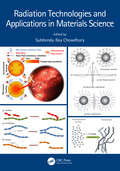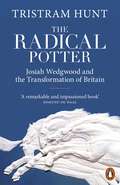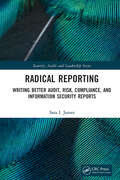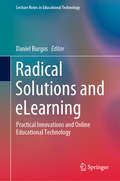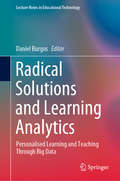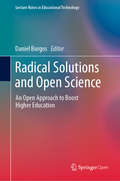- Table View
- List View
Radiation Technologies and Applications in Materials Science
by Subhendu Ray ChowdhuryThis book explains various kinds of non-ionizing and high-energy radiations, their interaction with materials and chemical reactions, and conditions of various kinds of materials development technologies including applications. It covers a processing-structure-property relationship and radiations used in developing many advanced materials used in various fields. It highlights application-oriented materials synthesis and modification covering a wide variety of materials such as plastics, rubber, thermo-set, ceramics, and so forth by various radiations. Features: Explains ionizing and non-ionizing radiation-assisted materials development technologies, for polymers, ceramics, metals, and carbons. Covers radiation-assisted synthesis, processing, and modification of all kinds of materials. Provides comparative studies, merits, demerits, and applications very systematically. Criss-crosses polymers science and technology, radiation technology, advanced materials technology, biomaterials technology, and so forth. Includes a section on 3D printing by LASER melting of CoCr alloys. This book is aimed at researchers and graduate students in materials science, radiation chemistry and physics, and polymer and other materials processing.
Radiation Technologies and Applications in Materials Science
by Subhendu Ray ChowdhuryThis book explains various kinds of non-ionizing and high-energy radiations, their interaction with materials and chemical reactions, and conditions of various kinds of materials development technologies including applications. It covers a processing-structure-property relationship and radiations used in developing many advanced materials used in various fields. It highlights application-oriented materials synthesis and modification covering a wide variety of materials such as plastics, rubber, thermo-set, ceramics, and so forth by various radiations. Features: Explains ionizing and non-ionizing radiation-assisted materials development technologies, for polymers, ceramics, metals, and carbons. Covers radiation-assisted synthesis, processing, and modification of all kinds of materials. Provides comparative studies, merits, demerits, and applications very systematically. Criss-crosses polymers science and technology, radiation technology, advanced materials technology, biomaterials technology, and so forth. Includes a section on 3D printing by LASER melting of CoCr alloys. This book is aimed at researchers and graduate students in materials science, radiation chemistry and physics, and polymer and other materials processing.
Radiation Technology for Polymers
by Jiri George DrobnyThis practical book sets the standard as a valuable, time-saving resource offering systematic fundamental information about industrial radiation technologies. This new edition explores updates to emerging applications of ultraviolet (UV) and electron beam (EB) radiation to polymer processing and offers updates throughout to detail changes changes, new trends, and general issues in radiation technology. It presents vital, cutting-edge information to aid further reduction of volatile organic compounds and toxic substances in the environment, develop alternative sources of energy, and harness energy in both medical and industrial applications. New features of this edition include: Stresses the practical aspects of UV/EB technology and its industrial application Includes updates on UV radiation processes and applications of UV radiation Explores new engineering data of selected commercial products Written by an expert with over forty years of experience, this book would make an excellent resource for scientists and engineers in the fields of materials science and polymer chemistry.
Radiation Technology for Polymers
by Jiri George DrobnyThis practical book sets the standard as a valuable, time-saving resource offering systematic fundamental information about industrial radiation technologies. This new edition explores updates to emerging applications of ultraviolet (UV) and electron beam (EB) radiation to polymer processing and offers updates throughout to detail changes changes, new trends, and general issues in radiation technology. It presents vital, cutting-edge information to aid further reduction of volatile organic compounds and toxic substances in the environment, develop alternative sources of energy, and harness energy in both medical and industrial applications. New features of this edition include: Stresses the practical aspects of UV/EB technology and its industrial application Includes updates on UV radiation processes and applications of UV radiation Explores new engineering data of selected commercial products Written by an expert with over forty years of experience, this book would make an excellent resource for scientists and engineers in the fields of materials science and polymer chemistry.
Radiation-Tolerant Delta-Sigma Time-to-Digital Converters (Analog Circuits and Signal Processing)
by Ying Cao Paul Leroux Michiel SteyaertThis book focuses on the design of a Mega-Gray (a standard unit of total ionizing radiation) radiation-tolerant ps-resolution time-to-digital converter (TDC) for a light detection and ranging (LIDAR) system used in a gamma-radiation environment. Several radiation-hardened-by-design (RHBD) techniques are demonstrated throughout the design of the TDC and other circuit techniques to improve the TDC's resolution in a harsh environment are also investigated. Readers can learn from scratch how to design a radiation-tolerant IC. Information regarding radiation effects, radiation-hardened design techniques and measurements are organized in such a way that readers can easily gain a thorough understanding of the topic. Readers will also learn the design theory behind the newly proposed delta-sigma TDC. Readers can quickly acquire knowledge about the design of radiation-hardened bandgap voltage references and low-jitter relaxation oscillators, which are introduced in the content from a designer's perspective. · Discusses important aspects of radiation-tolerant analog IC design, including realistic applications and radiation effects on ICs; · Demonstrates radiation-hardened-by-design techniques through a design-test-radiation assessment practice;· Describes a new type of Time-to-Digital (TDC) converter designed for radiation-tolerant application;· Explains the design and measurement of all functional blocks (e.g., bandgap reference, relaxation oscillator) in the TDC.
Radiative Heat Transfer in Participating Media: With MATLAB Codes
by Rahul Yadav C. Balaji S. P. VenkateshanThis book aims at providing a computational framework of radiative heat transfer in participating media. The book mainly helps engineers and researchers develop their own codes for radiative transfer analysis, starting from simple benchmark problems and extending further to industry scale problems. The computations related to radiative heat transfer are very relevant in iron and steel manufacturing industries, rocket exhaust designing, fire resistance testing, and atmospheric and solar applications. The methods to accurately treat the non-gray nature of the participating gases such as H2O, CO2, and CO are discussed along with considering particle radiation. The solver development based on these methods and its application to a variety of industry problems and different kind of geometries is a significant attraction in the book. The last section of the book deals with the use of artificial neural networks and genetic algorithm-based optimization technique for solving practical problems of process parameter optimization in industry. This book is a comprehensive package taking the readers from the basics of radiative heat transfer in participating media to equip them with their own solvers and help to apply to industry problems.
Radiative Heat Transfer in Turbulent Combustion Systems: Theory and Applications (SpringerBriefs in Applied Sciences and Technology)
by Michael F. Modest Daniel C. HaworthThis introduction reviews why combustion and radiation are important, as well as the technical challenges posed by radiation. Emphasis is on interactions among turbulence, chemistry and radiation (turbulence-chemistry-radiation interactions – TCRI) in Reynolds-averaged and large-eddy simulations. Subsequent chapters cover: chemically reacting turbulent flows; radiation properties, Reynolds transport equation (RTE) solution methods, and TCRI; radiation effects in laminar flames; TCRI in turbulent flames; and high-pressure combustion systems. This Brief presents integrated approach that includes radiation at the outset, rather than as an afterthought. It stands as the most recent developments in physical modeling, numerical algorithms, and applications collected in one monograph.
Radiative Processes in Discharge Plasmas (Nato ASI Subseries B: #149)
by Joseph M. Proud Lawrence H. LuessenRadiators in Hydronic Heating Installations: Structure, Selection and Thermal Characteristics (Studies in Systems, Decision and Control #101)
by Damian Piotr MuniakThis book addresses key design and computational issues related to radiators in hydronic heating installations. A historical outline is included to highlight the evolution of radiators and heating technologies. Further, the book includes a chapter on thermal comfort, which is the decisive factor in selecting the ideal heating system and radiator type.The majority of the book is devoted to an extensive discussion of the types and kinds of radiators currently in use, and to identifying the reasons for the remarkable diversity of design solutions. The differences between the solutions are also addressed, both in terms of the effects of operation and of the thermal comfort that needs to be ensured. The book then compares the advantages and disadvantages of each solution, as well as its potential applications.A detailed discussion, supported by an extensive theoretical and mathematical analysis, is presented of the computational relations that are used in selecting the radiator type. The dynamics of radiator heat output regulation are also covered, with particular emphasis on underfloor-surface radiators, for which this aspect is particularly important.The book closes with a chapter presenting computational examples. It includes numerous examples of calculations for all essential thermal parameters of radiator operation in heating installations.
Radical Abundance: How a Revolution in Nanotechnology Will Change Civilization
by K. Eric DrexlerK. Eric Drexler is the founding father of nanotechnology-the science of engineering on a molecular level. In Radical Abundance, he shows how rapid scientific progress is about to change our world. Thanks to atomically precise manufacturing, we will soon have the power to produce radically more of what people want, and at a lower cost. The result will shake the very foundations of our economy and environment.Already, scientists have constructed prototypes for circuit boards built of millions of precisely arranged atoms. The advent of this kind of atomic precision promises to change the way we make things-cleanly, inexpensively, and on a global scale. It allows us to imagine a world where solar arrays cost no more than cardboard and aluminum foil, and laptops cost about the same.A provocative tour of cutting edge science and its implications by the field's founder and master, Radical Abundance offers a mind-expanding vision of a world hurtling toward an unexpected future.
Radical by Nature: The Revolutionary Life of Alfred Russel Wallace
by James T. CostaA major new biography of the brilliant naturalist, traveler, humanitarian, and codiscoverer of natural selectionAlfred Russel Wallace (1823–1913) was perhaps the most famed naturalist of the Victorian age. His expeditions to remote Amazonia and southeast Asia were the stuff of legend. A collector of thousands of species new to science, he shared in the discovery of natural selection and founded the discipline of evolutionary biogeography.Radical by Nature tells the story of Wallace’s epic life and achievements, from his stellar rise from humble origins to his complicated friendship with Charles Darwin and other leading scientific lights of Britain to his devotion to social causes and movements that threatened to alienate him from scientific society.James Costa draws on letters, notebooks, and journals to provide a multifaceted account of a revolutionary life in science as well as Wallace’s family life. He shows how the self-taught Wallace doggedly pursued bold, even radical ideas that caused a seismic shift in the natural sciences, and how he also courted controversy with nonscientific pursuits such as spiritualism and socialism. Costa describes Wallace’s courageous social advocacy of women’s rights, labor reform, and other important issues. He also sheds light on Wallace’s complex relationship with Darwin, describing how Wallace graciously applauded his friend and rival, becoming one of his most ardent defenders.Weaving a revelatory narrative with the latest scholarship, Radical by Nature paints a mesmerizing portrait of a multifaceted thinker driven by a singular passion for science, a commitment to social justice, and a lifelong sense of wonder.
Radical by Nature: The Revolutionary Life of Alfred Russel Wallace
by James T. CostaA major new biography of the brilliant naturalist, traveler, humanitarian, and codiscoverer of natural selectionAlfred Russel Wallace (1823–1913) was perhaps the most famed naturalist of the Victorian age. His expeditions to remote Amazonia and southeast Asia were the stuff of legend. A collector of thousands of species new to science, he shared in the discovery of natural selection and founded the discipline of evolutionary biogeography.Radical by Nature tells the story of Wallace’s epic life and achievements, from his stellar rise from humble origins to his complicated friendship with Charles Darwin and other leading scientific lights of Britain to his devotion to social causes and movements that threatened to alienate him from scientific society.James Costa draws on letters, notebooks, and journals to provide a multifaceted account of a revolutionary life in science as well as Wallace’s family life. He shows how the self-taught Wallace doggedly pursued bold, even radical ideas that caused a seismic shift in the natural sciences, and how he also courted controversy with nonscientific pursuits such as spiritualism and socialism. Costa describes Wallace’s courageous social advocacy of women’s rights, labor reform, and other important issues. He also sheds light on Wallace’s complex relationship with Darwin, describing how Wallace graciously applauded his friend and rival, becoming one of his most ardent defenders.Weaving a revelatory narrative with the latest scholarship, Radical by Nature paints a mesmerizing portrait of a multifaceted thinker driven by a singular passion for science, a commitment to social justice, and a lifelong sense of wonder.
Radical Human Ecology: Intercultural and Indigenous Approaches
by Rose RobertsHuman ecology - the study and practice of relationships between the natural and the social environment - has gained prominence as scholars seek more effectively to engage with pressing global concerns. In the past seventy years most human ecology has skirted the fringes of geography, sociology and biology. This volume pioneers radical new directions. In particular, it explores the power of indigenous and traditional peoples' epistemologies both to critique and to complement insights from modernity and postmodernity. Aimed at an international readership, its contributors show that an inter-cultural and transdisciplinary approach is required. The demands of our era require a scholarship of ontological depth: an approach that can not just debate issues, but also address questions of practice and meaning. Organized into three sections - Head, Heart and Hand - this volume covers the following key research areas: Theories of Human Ecology Indigenous and Wisdom Traditions Eco-spiritual Epistemologies and Ontology Research practice in Human Ecology The researcher-researched relationship Research priorities for a holistic world With the study of human ecology becoming increasingly imperative, this comprehensive volume will be a valuable addition for classroom use.
Radical Human Ecology: Intercultural and Indigenous Approaches
by Rose RobertsHuman ecology - the study and practice of relationships between the natural and the social environment - has gained prominence as scholars seek more effectively to engage with pressing global concerns. In the past seventy years most human ecology has skirted the fringes of geography, sociology and biology. This volume pioneers radical new directions. In particular, it explores the power of indigenous and traditional peoples' epistemologies both to critique and to complement insights from modernity and postmodernity. Aimed at an international readership, its contributors show that an inter-cultural and transdisciplinary approach is required. The demands of our era require a scholarship of ontological depth: an approach that can not just debate issues, but also address questions of practice and meaning. Organized into three sections - Head, Heart and Hand - this volume covers the following key research areas: Theories of Human Ecology Indigenous and Wisdom Traditions Eco-spiritual Epistemologies and Ontology Research practice in Human Ecology The researcher-researched relationship Research priorities for a holistic world With the study of human ecology becoming increasingly imperative, this comprehensive volume will be a valuable addition for classroom use.
Radical Polymerisation Polyelectrolytes (Advances in Polymer Science #145)
by I. Capek J. Hernandes-Barajas D. Hunkeler J. L. Reddinger J. R. Reynolds C. WandreyRadical Polymerization: Kinetics and Mechanism (Macromolecular Symposia)
by Michael Buback A. M. Van HerkThis volume from the successful Macromolecular Symposia series presents the contributions from the IUPAC-sponsored International Symposium on "Radical Polymerization: Kinetics and Mechanism", held in Il Ciocco, Italy, in September, 2006. This was the fourth within the series of so-called SML conferences, which are the major scientific forum for addressing kinetic and mechanistic aspects of free-radical polymerization and controlled radical polymerization. SML IV again marked an important step forward toward the better understanding of the kinetics and mechanism of radical polymerization, which is extremely relevant for both conventional and controlled radical polymerization and for people in academia as well as in industry. Here, top international authors, such as K. Matyjaszewski, T. P. Davis and T. Fukuda, present their latest research. The five major themes covered were: Fundamentals of free-radical polymerization, heterogeneous polymerization, controlled radical polymerization, polymer reaction engineering, and polymer characterization.
The Radical Potter: Josiah Wedgwood and the Transformation of Britain
by Tristram HuntA spectacular new biography of the great designer, entrepreneur, abolitionist and beacon of the Industrial Revolution, from acclaimed historian and Director of the Victoria and Albert Museum, Tristram HuntJosiah Wedgwood, perhaps the greatest English potter who ever lived, epitomized the best of his age. From his kilns and workshops in Stoke-on-Trent, he revolutionized the production of ceramics in Georgian Britain by marrying technology with design, manufacturing efficiency and retail flair. He transformed the luxury markets not only of London, Liverpool, Bath and Dublin but of America and the world, and helping to usher in a mass consumer society. Tristram Hunt calls him 'the Steve Jobs of the eighteenth century'.But Wedgwood was radical in his mind and politics as well as in his designs. He campaigned for free trade and religious toleration, read pioneering papers to the Royal Society and was a member of the celebrated Lunar Society of Birmingham. Most significantly, he created the ceramic 'Emancipation Badge', depicting a slave in chains and inscribed 'Am I Not a Man and a Brother?' that became the symbol of the abolitionist movement.Tristram Hunt's hugely enjoyable new biography, strongly based on Wedgwood's notebooks, letters and the words of his contemporaries, brilliantly captures the energy and originality of Wedgwood and his extraordinary contribution to the transformation of eighteenth-century Britain.
Radical Reform in Soviet Defence Policy: Selected Papers from the Fourth World Congress for Soviet and East European Studies, Harrogate, 1990
by R. AllisonRadical Reporting: Writing Better Audit, Risk, Compliance, and Information Security Reports (Security, Audit and Leadership Series)
by Sara I. JamesMost people dread writing reports; they also dread reading reports. What they don’t realize is that the techniques that make writing more readable make it more powerful. This is especially relevant for professionals in areas such as audit, risk, compliance, and information security. This small volume provides the tools and techniques needed to improve reports. It does so through addressing crucial concepts all too often overlooked in the familiar rush to perform tasks, complete projects, and meet deadlines. These concepts – the role of culture in communication; the link between logic and language; the importance of organizing thoughts before writing; and how to achieve clarity – may seem academic or theoretical. They’re not. Unless writers understand their own thoughts, actions, and objectives, they cannot hope to communicate them at all – let alone clearly.
Radical Reporting: Writing Better Audit, Risk, Compliance, and Information Security Reports (Security, Audit and Leadership Series)
by Sara I. JamesMost people dread writing reports; they also dread reading reports. What they don’t realize is that the techniques that make writing more readable make it more powerful. This is especially relevant for professionals in areas such as audit, risk, compliance, and information security. This small volume provides the tools and techniques needed to improve reports. It does so through addressing crucial concepts all too often overlooked in the familiar rush to perform tasks, complete projects, and meet deadlines. These concepts – the role of culture in communication; the link between logic and language; the importance of organizing thoughts before writing; and how to achieve clarity – may seem academic or theoretical. They’re not. Unless writers understand their own thoughts, actions, and objectives, they cannot hope to communicate them at all – let alone clearly.
Radical Solutions and eLearning: Practical Innovations and Online Educational Technology (Lecture Notes in Educational Technology)
by Daniel BurgosEducational Technology is the right couple to a radical innovation. Thanks to the appropriate technology in the right context with the best fit to the target audience, education can be drastically improved, meaning a better performance, competence achievement, match with the user’s expectations and with the market needs. Serious games, Virtual reality, Augmented reality, Remote labs, Online learning, Blockchain, Mobile learning and many other key technologies allow for a better explanation of so many subjects, and even more: for a complete student involvement and a full teacher engagement into the educational system. Technology gives another angle to the same content, provides the user with a personalised experience and pushes the limits of knowledge a little further, every time. This book presents a number of radical innovations through technology, from experienced cases studies, to be replicated and inspired by; a powerful resource handbook for cutting-edge education.
Radical Solutions and Learning Analytics: Personalised Learning and Teaching Through Big Data (Lecture Notes in Educational Technology)
by Daniel BurgosLearning Analytics become the key for Personalised Learning and Teaching thanks to the storage, categorisation and smart retrieval of Big Data. Thousands of user data can be tracked online via Learning Management Systems, instant messaging channels, social networks and other ways of communication. Always with the explicit authorisation from the end user, being a student, a teacher, a manager or a persona in a different role, an instructional designer can design a way to produce a practical dashboard that helps him improve that very user’s performance, interaction, motivation or just grading. This book provides a thorough approach on how education, as such, from teaching to learning through management, is improved by a smart analysis of available data, making visible and useful behaviours, predictions and patterns that are hinder to the regular eye without the process of massive data.
Radical Solutions and Open Science: An Open Approach to Boost Higher Education (Lecture Notes in Educational Technology)
by Daniel BurgosThis open access book presents how Open Science is a powerful tool to boost Higher Education. The book introduces the reader into Open Access, Open Technology, Open Data, Open Research results, Open Licensing, Open Accreditation, Open Certification, Open Policy and, of course, Open Educational Resources. It brings all these key topics from major players in the field; experts that present the current state of the art and the forthcoming steps towards a useful and effective implementation. This book presents radical, transgenic solutions for recurrent and long-standing problems in Higher Education. Every chapter presents a clear view and a related solution to make Higher Education progress and implement tools and strategies to improve the user’s performance and learning experience. This book is part of a trilogy with companion volumes on Radical Solutions & Learning Analytics and Radical Solutions & eLearning.
Radical Solutions for Digital Transformation in Latin American Universities: Artificial Intelligence and Technology 4.0 in Higher Education (Lecture Notes in Educational Technology)
by Daniel Burgos John Willian BranchThis book presents how Digital Transformation is a requirement to upgrade Latin American universities to a next level in management, lecturing and learning processes and strategies. The book starts with a thorough introduction of the Latin American context addressing the three main topics in the book: Digital Transformation, Higher Education and Artificial Intelligence & Industry 4.0. They will be depicted by region, with a clear distribution between Central America & Mexico, Comunidad Andina (Perú, Colombia, Chile, Ecuador, Bolivia), Mercosur (Argentina, Brasil, Paraguay and Uruguay), and other countries. The book also shows how online learning is a key part of the transformation, with a clear focus on learning management systems, innovation and learning analytics. Further, personalised services for every single profile at the university (students, lecturers, academic managers) are presented to guarantee inclusive education service aggregation for networked campuses. Following, the book addresses strategy and overall services that concentrate on sustainability and revenue models integrated with a strategic planning. Finally a set of chapters will show specific experiences and case studies of direct application of Artificial Intelligence and Technology 4.0, where the readers can learn from and transfer directly into their educational contexts.
Radical Solutions for Education in a Crisis Context: COVID-19 as an Opportunity for Global Learning (Lecture Notes in Educational Technology)
by Daniel Burgos Ahmed Tlili Anita TabaccoThis book presents how to keep working on education in contexts of crisis, such as emergencies, zones of conflict, wars and health pandemics such as COVID-19. Specifically, this work shows a number of strategies to support global learning and teaching in online settings. Particularly, it first presents how to facilitate knowledge sharing and raising awareness about a specific crisis, to increase people’s safety, including educators and learners. The book then discusses various techniques, mechanisms and services that could be implemented to provide effective learning support for learners, especially in learning environments that they do not daily use, such as physical classrooms. Further, the work presents how to teach and support online educators, no matter if they are school teachers, university lecturers, youth social workers, vocational training facilitators or of any other kind. Finally, it describes worldwide case studies that have applied practical steps to keep education running during a crisis.This book provides readers with insights and guidelines on how to maintain learning undisrupted during contexts of crisis. It also provides basic and practical recommendations to the various stakeholders in educational contexts (students, content providers, technology services, policy makers, school teachers, university lecturers, academic managers, and others) about flexible, personalised and effective education in the context of crisis.
